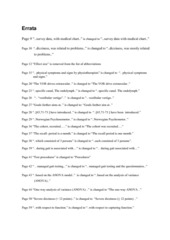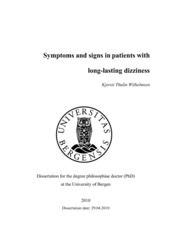| dc.contributor.author | Wilhelmsen, Kjersti Thulin | en_US |
| dc.date.accessioned | 2010-08-20T11:18:59Z | |
| dc.date.available | 2010-08-20T11:18:59Z | |
| dc.date.issued | 2010-04-29 | eng |
| dc.identifier.isbn | 978-82-308-0985-3 (print version) | en_US |
| dc.identifier.uri | https://hdl.handle.net/1956/4034 | |
| dc.description.abstract | The overall aim of this work is to increase the awareness on patients with dizziness of vestibular origin. Physiotherapists in Norway have until recently paid little attention to these patients, even though they might benefit from treatment by the profession. Substantial aims were to translate the Vertigo Symptom Scale, short form (VSS-SF) into Norwegian (VSS-SF(NV)), to explore the instrument’s measurements properties and to use the instrument to gain knowledge of the long term development of the condition in dizzy patients. Further aims were to develop a modified program of vestibular rehabilitation therapy (MVRT), and to explore balance control, musculoskeletal function and symptoms following implementation of the intervention in patients. Two samples (Sample 1: N = 503, Sample 2: N = 36), recruited by the National Centre for Vestibular Disorders, Department of Otorhinolaryngology, Head-Neck-Surgery, Haukeland University Hospital were included. In both samples, the mean age was around 50 years, and 60 % were women. The majority had vestibular related disorders and had complaints of dizziness of long duration. Following translation of the VSS-SF(NV), the first study comprised a survey on patients in Sample 1. Survey data from the sample, complemented by data from Sample 2, were used to explore the instrument’s measurement properties. Two subscales (vertigo/balance, autonomic/anxiety) were identified as in the original scale, and the VSSSF( NV) revealed satisfactory discriminative abilities. With respect to evaluative properties, sensitivity to change was satisfactory, but responsiveness of the Norwegian version of the scale should be examined in future studies. The second study combined survey data with medical chart information on patients in Sample 1. The latter was registered median (interquartile range, (IQR)) 4.6 (4.3) years earlier. Survey data gave information on the current state of dizziness, while medical chart data (symptom duration, neck pain, sway and diagnosis) in addition to sex and age, were used to explore potential prognostic factors. Severe dizziness, seen among those claiming current dizziness, was mostly related to problems with balance. More than half of the total group reported neck pain at the time of the survey, and dizziness in this sub-group was more severe than in those without neck pain. Symptom duration and neck pain predicted overall dizziness. Balance related dizziness was also predicted by these variables, in addition to sway and age. Neck pain was the only predictor of autonomic/anxiety related dizziness. The observed persistence and severity of dizziness may raise questions whether more efforts should be directed towards identifying the type of dizziness, rather than at diagnostic categorization when long-lasting dizziness is the issue. Questionnaire-based evaluations could assist in this process, and provide a better basis for specific rehabilitation. The implication of the findings may also raise questions with respect to treatment and referral routines for these patients. In the third study, a one-group pre-post test design was used to test patients from Sample 2 before and after the MVRT intervention. Focus was on balance control and dizziness. Two accelerometers positioned at upper and lower trunk detected body accelerations during gait. Results revealed attenuation pattern at trunk level in a cranial direction similar to that of healthy. Following intervention, increased stability of upper and increased mobility of lower trunk were identified, and also improvement in gait characteristics like cadence and step-length. The findings are compatible with improved control of balance, and were accompanied by improvement in self-reported balance by the VSS-SF(NV). The one-group pre-post design was also used in the fourth study which focused on musculoskeletal function. Patients in Sample 2 were examined by the Global Physiotherapy Examination (GPE-52) comprising 52 standardized items classifying the musculoskeletal system in 5 domains (posture, respiration, movement, muscle, skin). Prior to the MVRT intervention, musculoskeletal dysfunction was seen globally and also within the 5 domains indicated by higher scores than that of healthy persons. Following intervention, the musculoskeletal function improved. Decrease in the GPE-52 sum-scores globally and in the respiration and in movement domains, was found. Improvement in the latter was particularly localised to the upper body region. Self-reported symptoms relating to balance on the VSSSF( NV) did also improve. Based on the findings in the present work, it looks as if dizziness manifests and persists over time in some patients. The findings raise questions regarding the existing treatment and referral routines, and the need to offer organised vestibular rehabilitation at some point in time. As access to physiotherapy is dependent on referral from medical doctors, a closer collaboration between physiotherapy and the medical profession on this matter is desirable. A modified program of vestibular rehabilitation may improve the control of balance by promoting of more effective trunk attenuation and bodily movement strategies, and also improve self-perceived balance problems. | en_US |
| dc.language.iso | eng | eng |
| dc.publisher | The University of Bergen | eng |
| dc.relation.haspart | Paper I: BMC Ear, Nose and Throat Disorders 8(2), Wilhelmsen, K.; Strand, L. I.; Nordahl, S. H. G.; Eide, G. E.; Ljunggren, A. E., Psychometric properties of the Vertigo Symptom Scale - Short form. Copyright 2008 Wilhelmsen et al; licensee BioMed Central. Reproduced with permission. Published version. The published version is also available at: <a href="http://dx.doi.org/10.1186/1472-6815-8-2" target="_blank"> http://dx.doi.org/10.1186/1472-6815-8-2</a> | en_US |
| dc.relation.haspart | Paper II: BMC Ear, Nose and Throat Disorders 9(2), Wilhelmsen, K.; Ljunggren, A. E.; Goplen, F.; Eide, G. E.; Nordahl, S. H. G., Long-term symptoms in dizzy patients examined in a university clinic. Copyright 2009 Wilhelmsen et al; licensee BioMed Central. Reproduced with permission. Published version. The published version is also available at: <a href="http://dx.doi.org/10.1186/1472-6815-9-2" target="_blank"> http://dx.doi.org/10.1186/1472-6815-9-2</a> | en_US |
| dc.relation.haspart | Paper III: Wilhelmsen, K.; Nordahl, S. H. G.; Moe-Nilssen, R., 2010, Improved attenuation of trunk acceleration during walking following intervention in patients with unilateral vestibular Deficiencies. Full text not available in BORA. | en_US |
| dc.relation.haspart | Paper IV: Physiotherapy Research International 13(3), Kvåle, A.; Wilhelmsen, K.; Fiske, H. A., Physical findings in patients with dizziness undergoing a group exercise programme, pp. 162-165. Copyright 2008 John Wiley & Sons. Full text not available in BORA due to publisher restrictions. The published version is available at: <a href="http://dx.doi.org/10.1002/pri.402" target="_blank"> http://dx.doi.org/10.1002/pri.402</a> | en_US |
| dc.title | Symptoms and signs in patients with long-lasting dizziness | en_US |
| dc.type | Doctoral thesis | |
| dc.rights.holder | Copyright the author. All rights reserved | |
| dc.rights.holder | The author | |
| dc.subject.nsi | VDP::Medisinske Fag: 700::Helsefag: 800::Fysioterapi: 807 | nob |
| dc.subject.nsi | VDP::Medisinske Fag: 700::Klinisk medisinske fag: 750::Nevrologi: 752 | nob |




